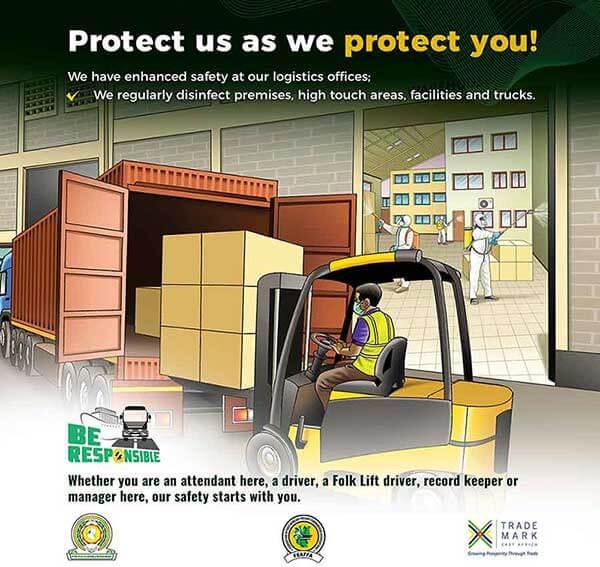
Our Projects are
Transforming African Trade
Quick Contacts
2nd Floor, Fidelity Insurance Centre Waiyaki Way, Westlands

Over 25,000 truck drivers have so far registered in the RECDTS system since the exercise was launched two weeks ago.
lans are underway to embed the Standard Operating Procedures (SOPs) in tackling Covid19 pandemic campaigns to the East Africa Community Regional Electronic Cargo and Driver’s Tracking System (RECDTS) app as the implementing team seek to reach a regional audience.
RWANDAIR
The Federation of East African Freight Forwarders Associations (FEAFFA) recently started a publicity campaign to promote the use of the SOPs, which will guide the industry in coping with Covid19 as the logistics industry seeks to spring back in a ‘ new normal’ environment.
Last week, FEAFFA conducted a training for the South Sudan stakeholders mainly from Nimule-Elegu border. The meeting was also attended by the representatives from Trademark East Africa (TMA), which is supporting the implementation of the project in the region.
“We plan to embed COVID19 SOP materials on the RECDTS app. The SOP messages will be tailored to create awareness among the drivers through the app,” FEAFFA president Mr. Fred Seka said, adding that there are plans to work with health officials and other relevant officers at all other border entry-exit points to sensitize the industry on the new SOPs.
Another engagement meeting especially with system developers is scheduled in a week’s time before the materials are finally embedded on the app, added Seka.
Over 25,000 truck drivers have so far registered in the RECDTS system since the exercise was launched two weeks ago. An average of between 3,000 to 4000 drivers are active on the system per day along the corridor, providing an ideal platform for the for any social media campaigns.
Most of the registered drivers are from Uganda where piloting was done before rolling out in Kenya. Focus is now shifting to Rwanda, Tanzania, South Sudan Burundi and Democratic Republic of Congo, the regional countries served by Central and Northern Corridors.
FEAFFA has also been running SOP campaigns on its social media platforms since the exercise was launched. Through this engagement, close to 500,000 users have been reached through Facebook, Twitter, YouTube and LinkedIn.
However, there have been a few teething problems in Kenya on electronic Covid 19 certificate. Kenya Transporters Association (KTA) Chief Executive Officer Mr Dennis Ombok said that the long queues at the Malaba and Busia were caused by the delays in releasing results electronically by the Ministry of Health
“As transporters, we would encourage anything that allows efficient flow of the cargo along the corridors,” Ombok said, adding that the system ought to have been piloted separately in each country to fill the gaps, which are currently being addressed.
The SOPs were developed by a team of experts in cargo transport, Warehousing, Freight Forwarding, Customs clearance and Public health. They were sent to the different stakeholders for input.
Since the COVID19 messages were sanctioned by WHO and EAC, FEAFFA is working closely with the Ministries of Health in each partner state to complement efforts geared towards stopping the spread of the virus, Seka said.
This initiative is being supported by the TMA. It is being rolled out in collaboration with the Kenya Transporters Association (KTA), Regional Lorry Drivers and Drivers Association (RLDA), Tanzania Truck Owners Association (TATOA) and Transporters Association of Tanzania (TAT).
Other collaborators include the Association des Transporteurs Internationauz du Burundi (ATIB) and Association de Transporateurs et Transitaires Agrees du Rwanda (ATAR).
This application was conceived to address the challenges manual certificates faced that included multiple testing of truck drivers at border crossing since there was no framework of mutual recognition of testing and test results across borders.
Read the original article
Disclaimer: The views and opinions expressed in this article are those of the authors and do not necessarily reflect the official policy or position of TradeMark Africa.